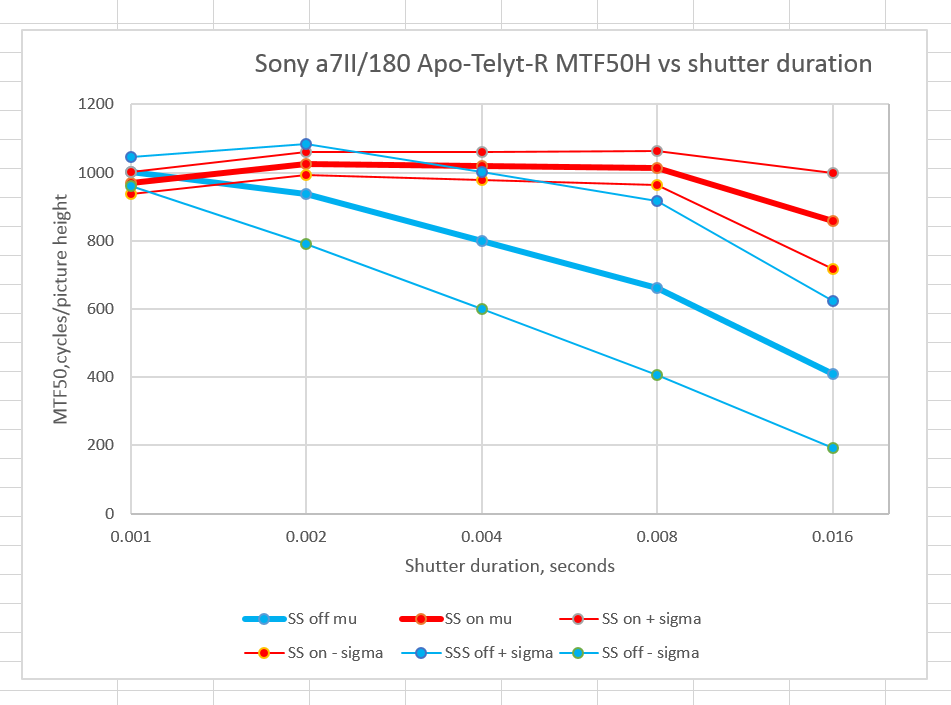I tested the performance of the in-body image stabilization (IBIS; Sony calls it Steadyshot) on the Sony alpha 7 Mark II (a7II) with 16mm, 28mm, 55 mm, and 180mm lenses. The improvements over handholding without the IBIS turned on were impressive, both in reduction of the average amount of blur, and the tightening of the spread in blur between groups of shots.
It has been my experience in the past with optically-stabilized lenses — mostly the Nikon VR lenses — that if you’re not careful, turning on the image stabilization can actually make things worse, as the shutter is open while the camera and lens combination are frantically trying to get the camera motion figured out.
Does IBIS suffer from the same problem? I set out to answer that question.
Here’s my test protocol:
- The camera: the Sony a7II.
- The lens: the Leica 180mm f/3.4 Apo-Telyt-R.
- The lighting: a single Fotodiox LED-200WA-56 daylight balanced flood.
- ISO set to 1000, f-stop set to 8,
- Focusing manually using maximum magnification wide open,
- Drive set to single
- EFCS on
- Manual exposure mode.
- Bring the camera quickly to the eye, then press the shutter button all the way down. Don’t wait for the image to stabilize.
- Exposure protocol: Light to maximum,, shutter to 1/1000 second, make 16 exposures, Turn the light down a stop, make 16 exposure, until you get to 1/60 of a second.
- Make one series with IBIS on, and one with it off.
- Develop in Lightroom 5.7.1 with standard settings.
- Crop, export as TIFFs, analyze for horizontal edge and vertical edge MTF50 in Imatest.
- Export the results to Excel, crunch the stats, and graph.
The results:
The vertical axis is the MTF50 for the image: the point where, as the spatial frequency of the subject matter increases, the response on the sensor is reduced to half its very-low-frequency value. The units of spatial frequency are cycles per picture height. Since the a7II has a picture height of 4000 pixels, the highest that the MTF50 should ever get is 2000 cycles per picture height. 1500 is exemplary performance.
The horizontal axis is the shutter duration. 0.001 seconds, the number at the left edge, is 1/1000 second. 0.016 is 1/60 second.
The heavy lines are the average for all 16 exposures. The red is with IBIS on, and the blue is with is off (In the legend, I call IBIS “SS”, for SteadyShot). The light lines are the average plus one standard deviation and the average minus one standard deviation. If the statistics for handheld MTF50 turn out to be Gaussian, about two thirds of the images will fall between the two narrow lines.
You can see that IBIS never makes things worse, and at shutter speeds of 1/125 and 1/60, actually helps thing quite a lot.
Good technique is still worth a lot, though. Consider this set of curves using the “Pete Souza” grip: left palm under base, left fingers bracing the underside of the front part of the lens, elbows against chest, and following this rifle-range release protocol: Inhale, exhale, brace gently, think calm thoughts, squeeze the shutter release, remembering to “pull through”.
The take home lesson is that you don’t have to be afraid to use IBIS if you’re in a hurry.
Why isn’t 1/1000 better than 1/500 in the sloppy technique curves? Beats me. I bet it wouldn’t be if I made the sample space much larger.


Great Blog Jim! Just was wondering as I was reading through your test protocol list in the series of a7II IBIS testing and didn’t see anything on dialing the Steadyshot Adjust to match the focal length. Was that performed?
Thanks!
>Was that performed?
Yes, it was.
Jim
Just speculating: the drop-off at 1/1000s might be related to vibration of the second shutter curtain? I’d think that at faster speeds that vibration is relatively more influential.
I agree. See this:
http://blog.kasson.com/?p=8509